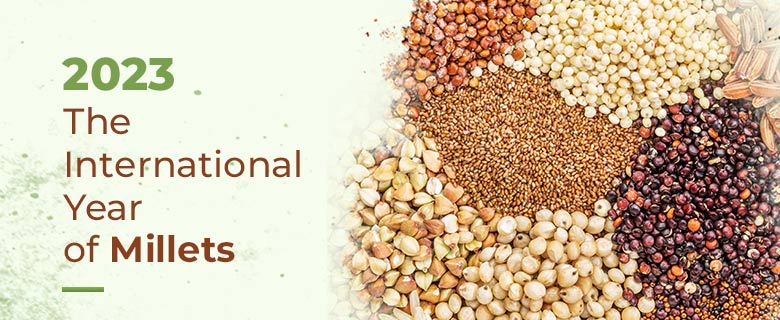
2023 – The International Year of Millets
With an aim to create mass awareness and increase the production and consumption of millets, the United Nations with the adjunct of the Indian government has declared 2023 the International Year of Millets (IYM).
Why was this action needed?
Millets were removed from our staple diets due to fast consumerism and industrialization of the food, depriving us of nourishment after colonization.
So, over the years, many leaders, activists, humanitarians, Ayurvedic doctors, NGOs, small business owners, and indigenous tribes, worked really hard to make the local panchayat and state governments aware of this need again.
Soon the Indian government spearheaded the effort, and the idea was presented to the UN General Assembly. The UN council recognized the health advantages of Millets and proclaimed 2023 as the International Year of Millets (IYM).
Why will India take the lead in promoting the year of Millets?
In different Indian states, 600+ indigenous millet seed varieties have been documented. Therefore, India holds the key to raising awareness about the consumption and distribution of these “seed-cereals” or seed grains.
In addition, we can introduce millet-consuming practices and molecular food gastronomy techniques used by our forefathers to the general public around the world. However, a team effort will be needed, particularly from end users, nutritionists, health specialists, and linguists.
What should you know about Millets?
Small-seeded millets have been farmed for over 10,000 years and are a common crop in developing nations like India. Its short growing season, resistance to drought, and ability to grow in poor, infertile soils are advantages Indian farmers leverage throughout the year.
Types of Millets
- Sorghum Millet (Jowar)
- Proso Millet (Chena / Barri)
- Pearl Millet (Bajra)
- Foxtail Millet (Kakum / Kangni)
- Finger Millet (Ragi)
- Browntop Millet (Korle)
- Barnyard Millet (Sanwa)
- Little Millet (Moraiyo)
- Buckwheat Millet (Kuttu)
- Amaranth Millet (Rajgira)
- Kodo Millet
Sorghum (jawar), Pearl Millet (bajra), and Finger Millet (ragi) are major millets as they are bigger in size and also commonly consumed in India. Conversely, little millets – Foxtail Millet (Kakum / Kangni), Browntop Millet (Korle), Barnyard Millet (Sanwa), etc. are also quite healthy but not so popular.
No matter big or small, all millets are packed with nutrients. They are great for gut health and preventing inflammatory bowel disease. Also, they are helpful for preventing cardiovascular diseases and have antioxidants that delay aging and boost metabolism.
What are the main qualities of millets?
From an Ayurvedic perspective, millet has the following qualities:
- Taste – sweet, astringent
- Vipaka (taste conversion after digestion) – pungent (katu)
- Virya (potency) – slightly hot (kinchith ushna)
- Ruksha – dry in nature
- Kleda shoshakam – dries up excess body moistness
- Badda vitkam – constipating in nature
- Avrishyam – non aphrodisiac
What are its medicinal qualities?
According to Ayurveda, millet is regarded as Sweet, Hot, Dry, and Light. This makes it a somewhat unique grain because it counteracts the moist stickiness that might come from consuming other heavier grains.
Millet is utilised as ‘food medicine’ in the treatment of high Ama, dull Agni, diabetes, excess weight, oedema, and other excess Kapha (mucous/fluid) diseases because of its heating and drying effects.
However, if consumed in excess, it may aggravate Vata or Pitta, but if it is soaked and cooked with some cooling spices (like fennel seeds and coriander) and a little oil, it can be converted into a grain that is more tridoshic.
How to use millet?
Millet is gluten-free, low in lectin activity, and high in insoluble fibre, phosphorous, potassium, magnesium, and folate. However, it has a relatively high GI (60-70), so it should be cooked with good quality fat/oil and extra fibre to slow down the GI of the whole dish.
Note: Prior to cooking, millets are often crunchy and bitter but taste delicious afterward.
Benefits of cooked millet
Well-cooked millets are light to digest, appetizing, and carminative in nature. In addition, they help with the following problems:
- Breathlessness
- Splenic disorders
- Liver disorders
- Gudagata vikaras like haemorroids, fissure, fistula, etc.
Note: Excess intake can increase Vata dosha.
How to eat millet?
Millets can be popped, fermented to make drinks, formed into a batter by combining tiny amounts of wheat or rice, added to salads, flattened to make Indian bread, and eaten as desserts, making them suitable for all meals.
In addition, millet can be used whole in soups or as a side dish to meals. When using it in soups it just needs to be soaked for a couple of hours before cooking. Millet flour can also be used to make porridge, puddings, hot cakes, and baked cakes!
Millet recipes
- Appalu – It is a crispy snack prepared from Bengal gram and pearl millet.
- Samaipayasam – It is a sweet (kheer) preparation.
- Korramurukulu – It is a crispy savoury snack, prepared from Bengal gram flour and foxtail millet.
Beverages
- Sur – It is a finger millet-based fermented beverage.
- Madua – It is a finger-millet-based beverage prepared in Arunachal Pradesh.
- Oshikundu – It is prepared by fermenting pearl millet meal (Mahlangu), malted sorghum, bran, and water.
- Koozh – It is prepared by fermenting millet flour and rice.
Final Thoughts
Diabetes, obesity, and other lifestyle disorders, along with the consequences they cause, have recently reached virtually epidemic levels. In certain high-income nations, it has even overtaken all other causes of death. So, 2023 – International Year of Millets is a good step towards a healthier lifestyle.
You can also reap the remarkable advantages of millet by creating a tailored diet for yourself. To know more, schedule an online ayurveda doctor appointment and receive professional guidance on personal health management, weight loss, and lifestyle plans from qualified Vaidyas.





0 Comment
No comments found.Thank you. Your comment will be visible after an approval.
Add your comment